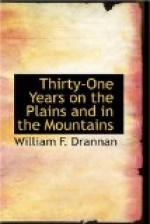In one month I returned to the fort as per contract and started in hunting.
There was so much stock around the fort that I had to go from ten to twenty miles to find deer, and sometimes further to find buffalo.
After I had hunted about three weeks Jim Bridger came over to try to make a bargain with the company in regard to buying furs and buffalo robes.
Up to this time the Kiowa had not traded any at this fort. In fact, there had been but little trading done among them, yet they were in the heart of the buffalo country in the fall of the year, being located on the Arkansas river, one hundred miles west from the Big Bend. We made a bargain to work for Bent and Roubidoux by the month, they to furnish us.
They thought the best plan would be to buy a load of robes and return with it, and then go back again, for by so doing we would not have to run chances of being robbed by other tribes as we would by waiting until spring to pack over to the fort.
We started about the first of November for the Kiowa village, with thirty-two pack-horses and a Mexican boy to help us. This was just the time of year that the buffalo were moving south for the winter, and they travel much slower and are much harder to frighten than in the spring when they are traveling the other way. I attributed this to their being so much fatter in the fall of the year, for in the fall one would never see a poor buffalo except it was either an old male or one that had been crippled; and their hides are much more valuable than those taken off in the spring.
On arriving at the village we found that the Indians had a new chief, whom neither of us were acquainted with. His name was Blackbird. The old chief, Black Buffalo, who fed us on dog meat when we were on our way from St. Louis to Taos, ten years before, having died, Blackbird was appointed in his place, and we found him to be a very intelligent Indian. He said his people were glad to have us come among them and that they would be pleased to trade with us.
We stayed there about two weeks before offering to buy a hide or fur of them, but would show our goods quite frequently in order to make them anxious, and by doing so we would be able to make a better bargain with them.
After staying there about two weeks we told the chief that on a certain day we would be ready to trade with his people, putting the date off about one week.
When the day arrived the Indians came in from all quarters to trade furs and robes, bringing from one to one dozen robes to the family. The squaws brought the robes, and the bucks came along to do the trading, and we got many a first-class robe for one string of beads, which in St. Louis would cost about ten cents. We traded for enough furs in one day to load our entire pack-train of thirty-two horses.




